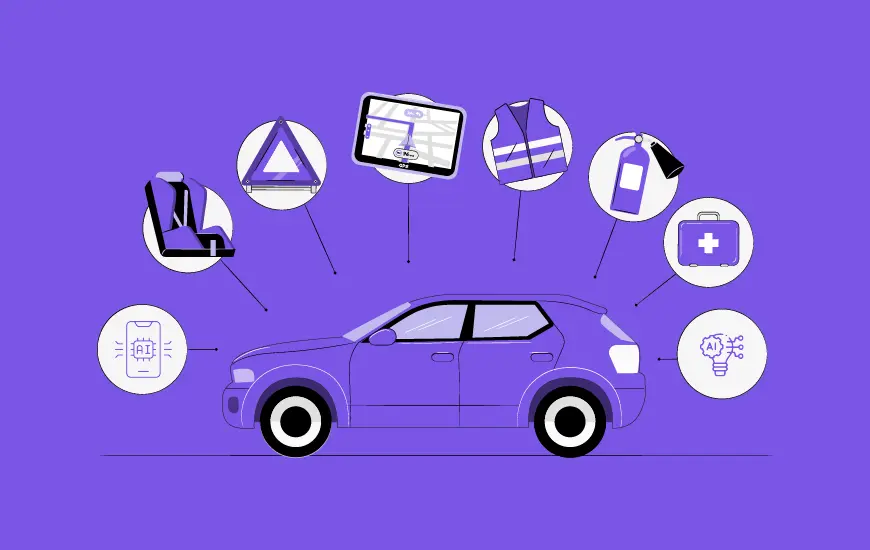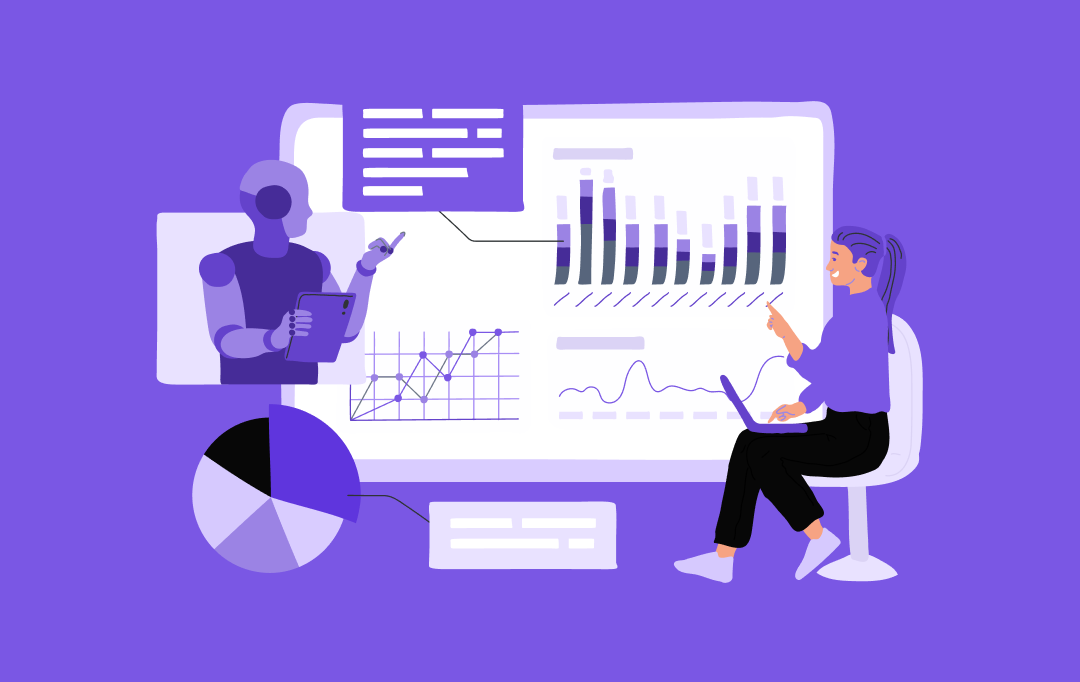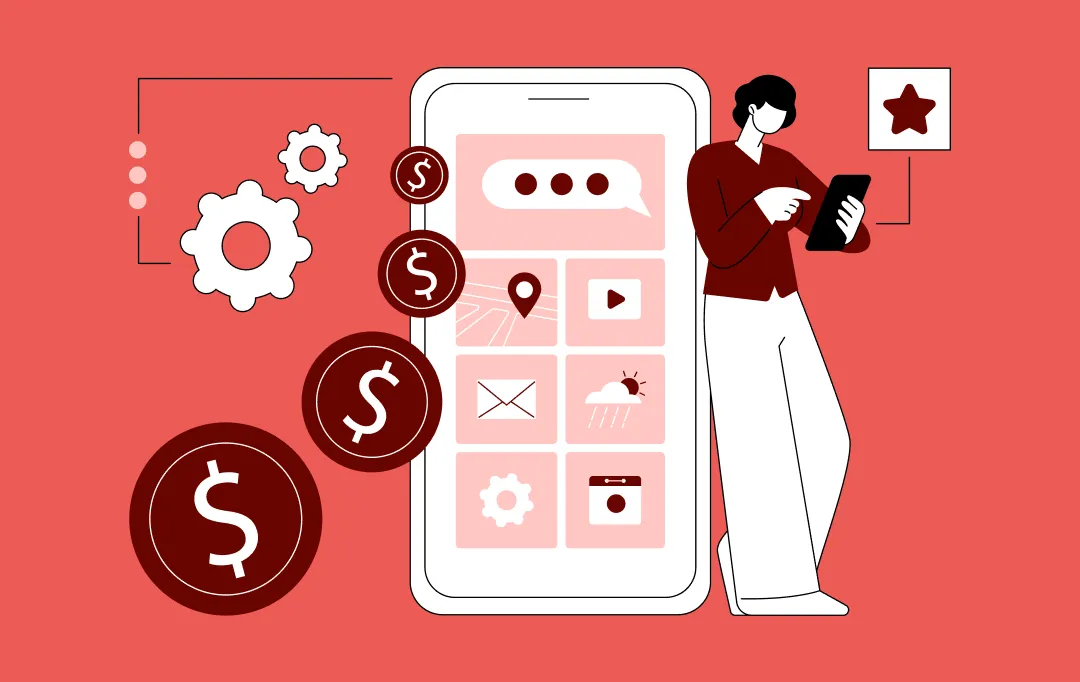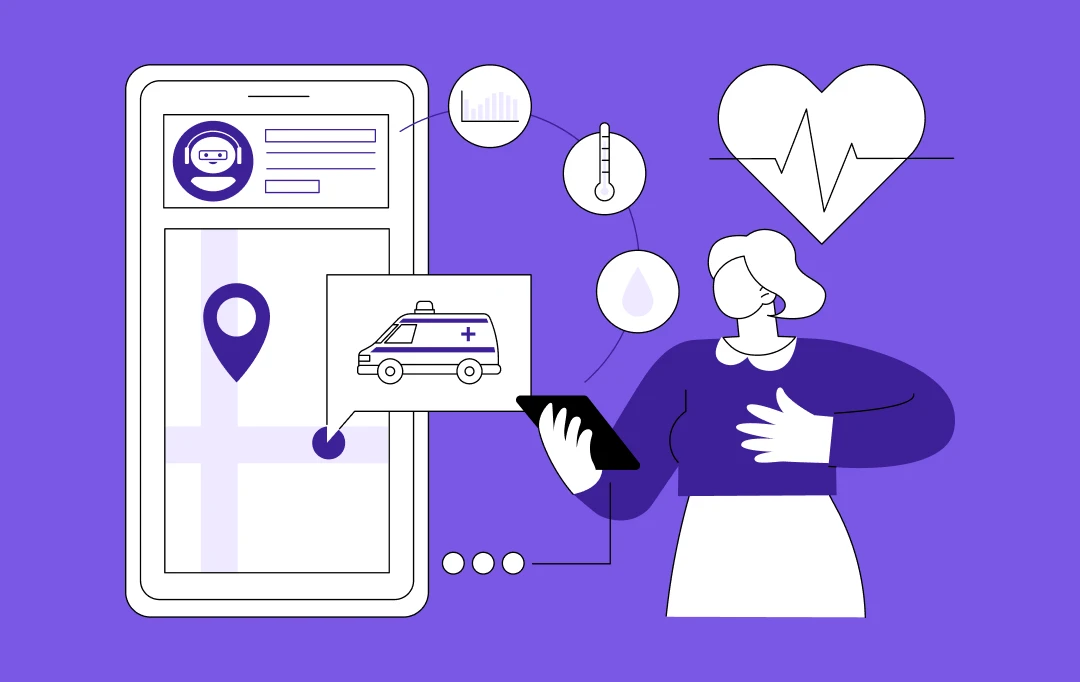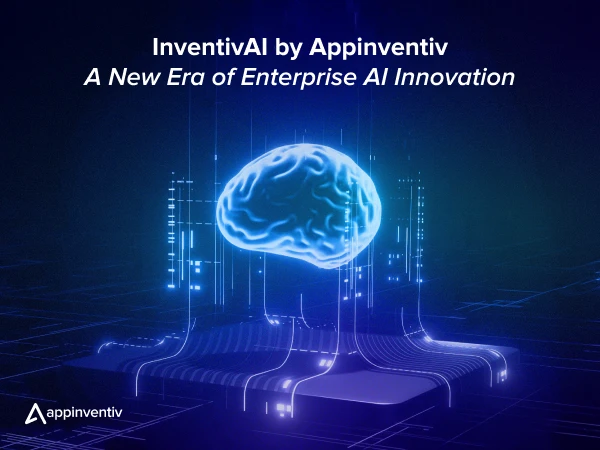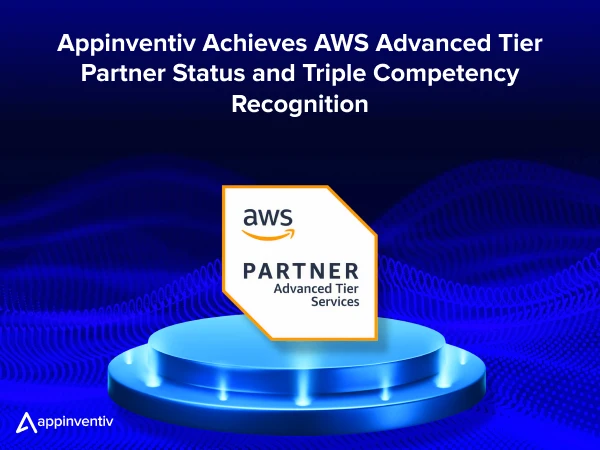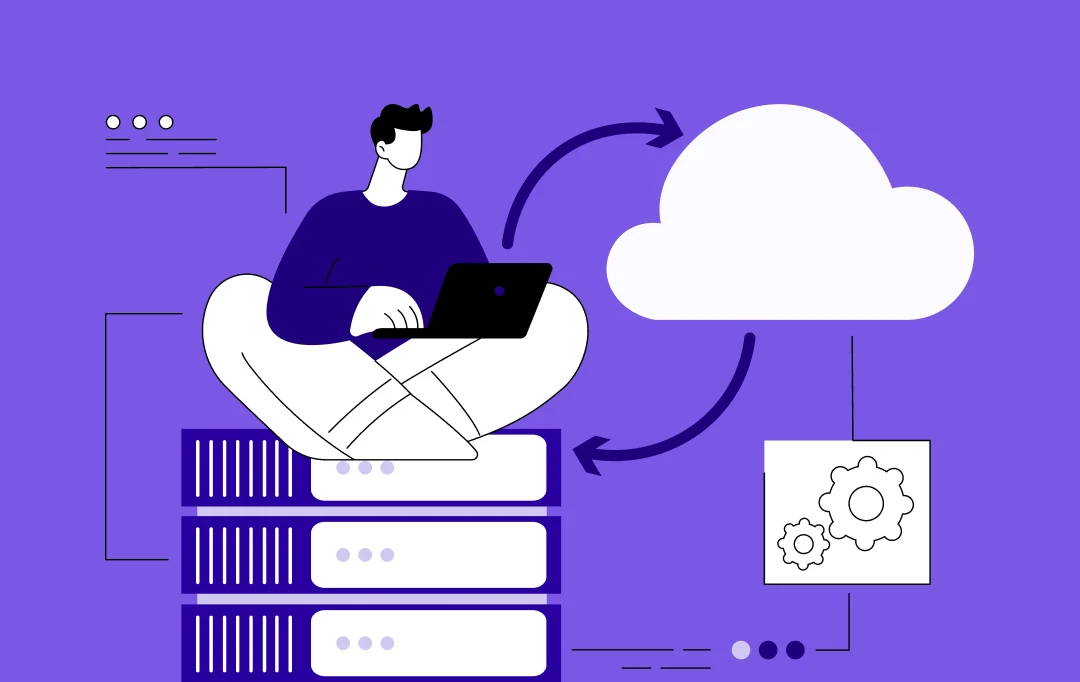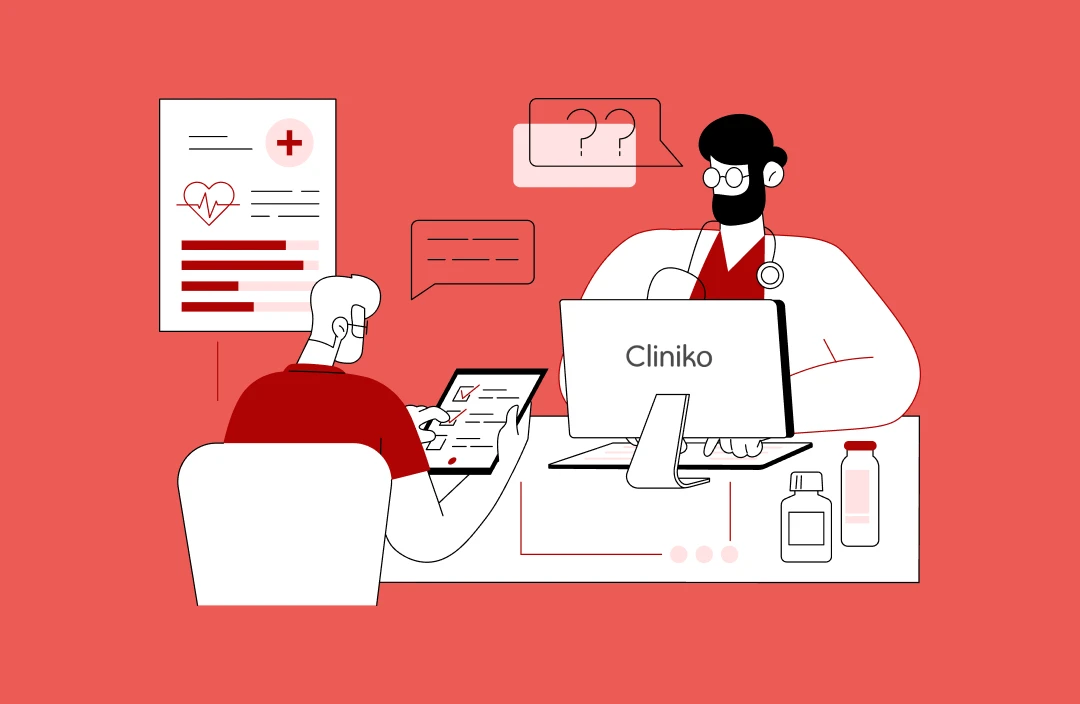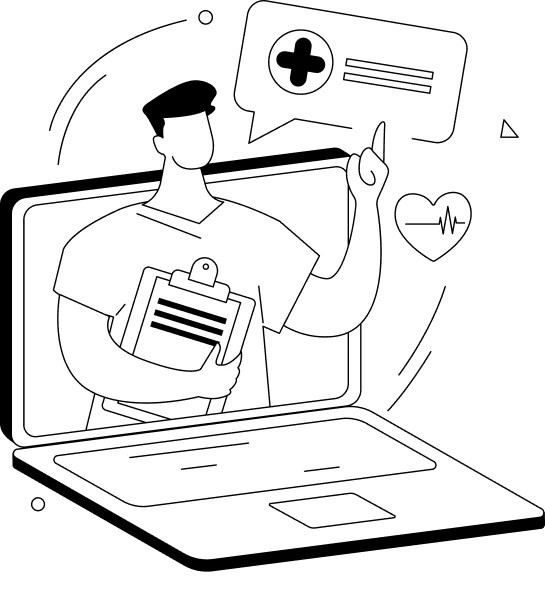- Overview of the Cliniko-like Healthcare Practice Management Software Development Costs
- How to Reduce Cliniko-like Software Development Cost Without Compromising Quality
- The Must-Have Cliniko-like Software Development Features
- User Experience Elements that Can Impact the Cliniko like Software Development Cost
- Tech Stack Powering Cliniko-Like Healthcare Practice Management Software Development Costs
- Healthcare Practice Management Software Development Process - The Steps
- Monetization Models for Your Version of Cliniko 2.0
- How to Get a Competitive Edge Over Cliniko
- Appinventiv’s Role in Creating Feature-rich Healthcare Practice Management Software
- FAQs
Imagine launching a healthcare software business where hospitals, clinics, and independent practitioners can seamlessly adopt your platform as their own – fully branded, customized, and ready to streamline operations. With the healthcare industry rapidly digitizing, practice management solutions are becoming a lucrative opportunity for entrepreneurs looking to enter the space.
Platforms like Cliniko have set a high standard, offering features like appointment scheduling, patient records, billing, and telehealth – all wrapped in an intuitive interface. But building a competitive alternative isn’t just about replicating features; it requires careful planning, compliance with healthcare regulations, and a scalable infrastructure.
So, how much does it really cost to develop healthcare practice management software like Cliniko? What factors influence the budget, and where can you optimize costs without compromising on quality?
While the costs typically range from $40,000 to $300,000+, this guide breaks down everything you need to know, from core development costs to hidden expenses, so you can make informed decisions before stepping into this growing market.
Overview of the Cliniko-like Healthcare Practice Management Software Development Costs
The Cliniko-like software development cost can vary significantly based on the complexity of the platform, the level of customization required, and the compliance regulations it must meet. A software solution designed for solo practitioners will have vastly different requirements, and costs, compared to a scalable enterprise-grade platform built for hospital networks.
To make things simpler, below, we have listed a rough estimate of the healthcare practice management software development costs based on complexity levels.
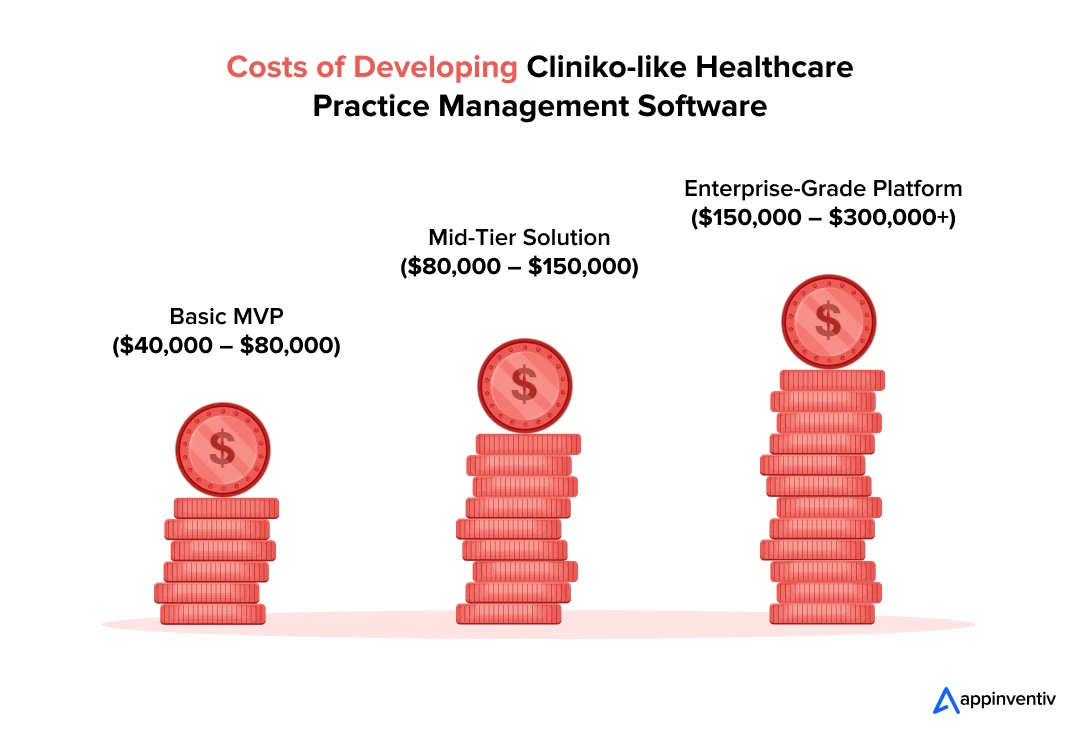
- Basic MVP ($40,000 – $80,000) – This is the most cost-effective healthcare practice management software development option for getting a working product into the market. It includes fundamental features like patient scheduling, basic invoicing, and limited user roles. Ideal for small clinics or independent practitioners looking for a simple, no-frills solution. While functional, this version lacks deep integrations with EHRs, automation, or advanced analytics.
[Also Read: How Much Does It Cost to Book a Healthcare Appointment Scheduling App like HotDoc?] - Mid-Tier Solution ($80,000 – $150,000) – A more robust version with features like electronic health record integration, telehealth capabilities, automated appointment reminders, and multi-user access. This level of complexity is well-suited for growing clinics and small hospital chains that need a more sophisticated system without going fully enterprise-level.
- Enterprise-Grade Platform ($150,000 – $300,000+) – This is a fully scalable, high-performance software built for hospitals, large clinic networks, and multi-specialty medical groups. It includes AI-driven analytics, predictive scheduling, compliance with HIPAA or My Health Record, seamless interoperability with other healthcare systems, and advanced security measures.
A critical point to consider here is that the cost to develop healthcare practice management software like Cliniko should also factor in ongoing maintenance, security updates, and support.
How to Reduce Cliniko-like Software Development Cost Without Compromising Quality
Cliniko-like healthcare practice management software development costs are a significant investment, but there are several strategies to manage these costs effectively.
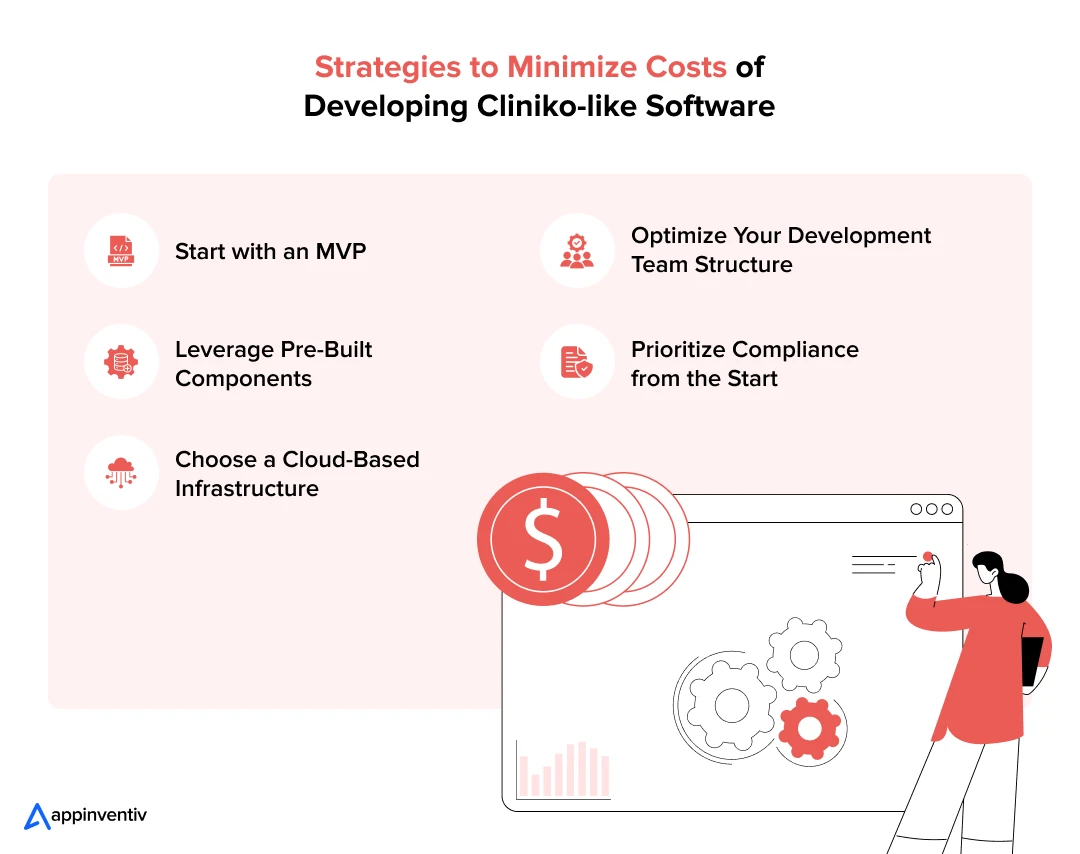
- Start with an MVP – Instead of aiming to create a platform like Cliniko full-fledgedly from day one, focus on core functionalities that provide immediate value. Once you gather user feedback and understand real-world needs, you can iterate and expand, avoiding unnecessary upfront expenses.
- Leverage Pre-Built Components – Developing every single one of the Cliniko-like software development features from scratch can be expensive and time-consuming. Instead, use existing APIs and third-party integrations for features like appointment scheduling, billing, and even telehealth. Many regulatory-compliant solutions are available that can integrate seamlessly into your platform.
- Optimize Your Development Team Structure – Hiring an in-house healthcare practice management software development team is costly, especially if you need experts in healthcare regulations, cybersecurity, and cloud architecture. A hybrid approach – where core project management stays in-house while development is outsourced to a specialized firm – can significantly lower expenses without sacrificing expertise.
- Prioritize Compliance from the Start – Regulatory compliance (HIPAA, GDPR, or My Health Record) isn’t optional. Retrofitting security measures and compliance protocols after development can be incredibly expensive. Working with developers who have experience in healthcare software ensures compliance is built into the foundation, saving you from costly revisions later.
[Also Read: How to Build a HIPAA-Compliant App?] - Choose a Cloud-Based Infrastructure – On-premise hosting requires significant upfront investment in hardware, security, and maintenance. Cloud-based deployment using AWS, Azure, or Google Cloud offers flexibility, scalability, and cost savings, as you only pay for the resources you use.
While cutting costs is important, it should never come at the expense of security, compliance, or user experience. Assuring that is something that can only be achieved when you perfectly assemble all the major factors influencing the cost of software development like Cliniko like features, UI/UX, and tech stack.
Let’s take up the factors one at a time.
The Must-Have Cliniko-like Software Development Features
A strong practice management system isn’t just about digitizing operations – it’s about creating a seamless workflow that enhances efficiency, reduces administrative burden, and improves patient care. Whether used by independent practitioners, clinics, or large hospital networks, the software needs to cover essential areas such as appointment scheduling, health records management, financial processing, and business administration.
Here’s a closer look at the key features that make up a critical part of healthcare practice management software development.
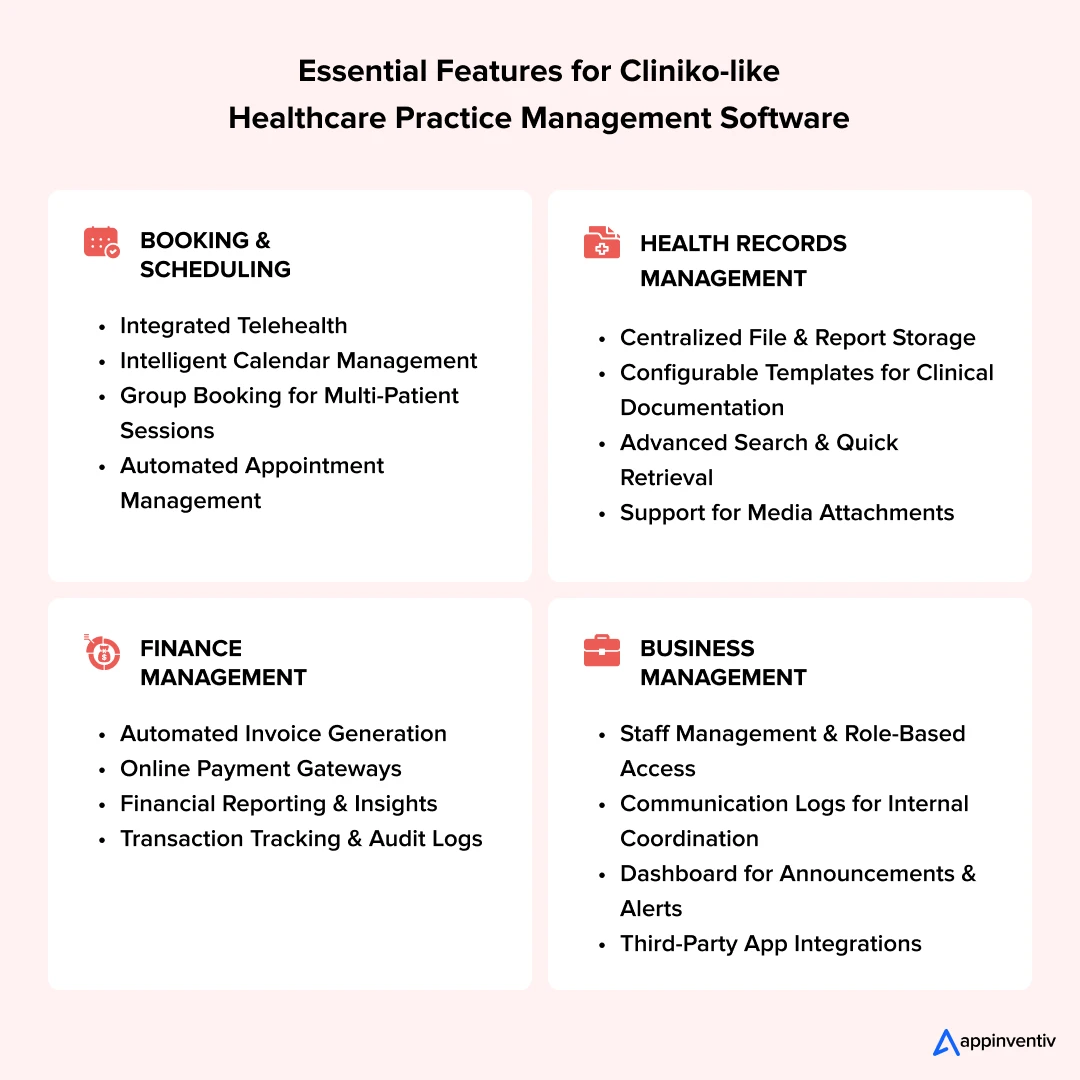
Booking & Scheduling
Managing patient appointments is a critical function to consider when you create a platform like Cliniko. An efficient scheduling module ensures a smooth booking experience for both patients and healthcare providers while reducing no-shows and scheduling conflicts.
- Integrated Telehealth – With virtual consultations becoming mainstream, the software should support secure video conferencing and encrypted communication for remote patient interactions. Integrated telehealth capabilities also ensure that patient records, prescriptions, and treatment histories are easily accessible during online consultations.
[Also Read: 7 Telemedicine Trends Shaping the Future of Healthcare] - Intelligent Calendar Management – A centralized calendar allows practitioners to set their availability, define consultation slots, and prevent double-booking. Synchronization with external calendars (Google, Outlook) ensures real-time updates, helping practitioners manage their schedules effortlessly.
- Group Booking for Multi-Patient Sessions – Many practitioners, such as physiotherapists or mental health professionals, require group session scheduling. The system should support multi-patient appointments, allowing clinics to set up recurring group therapy sessions or family consultations.
- Automated Appointment Management – Patients should be able to book, reschedule, or cancel appointments online, while the system automatically sends confirmations, reminders, and follow-ups via SMS or email. Smart scheduling features, like waitlist management and slot optimization, help maximize efficiency.
Health Records Management
A well-structured health records system, while directly impacting the healthcare practice management software development cost, ensures that medical professionals can access and update patient information in real time. Security and compliance are key considerations, as the system must adhere to HIPAA, GDPR, or My Health Record regulations, depending on the region.
- Centralized File & Report Storage – The system should securely store all patient-related files, including prescriptions, lab results, medical history, and doctor’s notes. Cloud storage with role-based access ensures that only authorized personnel can retrieve sensitive data.
- Configurable Templates for Clinical Documentation – Standardized templates for progress notes, treatment plans, and medical assessments save time while ensuring consistency in documentation. Clinics can customize these templates based on their specific workflow requirements.
- Advanced Search & Quick Retrieval – Searching for patient records, previous treatment plans, or test results should be instant. AI-powered search capabilities can help practitioners find relevant information using keywords, dates, or tags.
- Support for Media Attachments – The ability to upload and store images, X-rays, MRIs, and scanned documents within the patient’s profile allows for better diagnosis and treatment planning. Secure encryption ensures that sensitive files are protected against unauthorized access.
[Also Read: How to Develop a Radiology Information System?]
Finance Management
Handling payments, invoices, and financial reporting is one of the biggest administrative challenges for healthcare providers. A robust financial module streamlines revenue management and ensures a hassle-free payment experience for both clinics and patients.
- Automated Invoice Generation – The system should automatically generate invoices based on consultations, treatments, and procedures, reducing manual work and minimizing billing errors.
- Online Payment Gateways – Secure payment gateway integration allows patients to pay via credit/debit cards, digital wallets, and insurance claims. Automated payment reminders help clinics reduce outstanding balances and improve cash flow.
- Financial Reporting & Insights – Real-time revenue tracking, expense monitoring, and profitability reports provide valuable insights into the financial health of the practice. Advanced reporting tools can help identify trends, flag irregularities, and forecast revenue growth.
- Transaction Tracking & Audit Logs – A transparent tracking system ensures that every financial transaction is logged and accessible, helping clinics maintain accountability and regulatory compliance.
Business Management
Beyond patient care, when you create a platform like Cliniko, it should help clinics and hospitals handle day-to-day operations, staff coordination, and internal communication. A well-structured business management module ensures that everything runs smoothly behind the scenes.
- Staff Management & Role-Based Access – Assigning roles and permissions ensures that doctors, nurses, administrators, and billing staff have access only to the data they need. The system should also track staff working hours, shift schedules, and leave requests.
- Communication Logs for Internal Coordination – Keeping track of internal discussions, patient handovers, and interdepartmental communications helps improve collaboration among healthcare professionals. A centralized log ensures that important updates and decisions are documented.
- Dashboard for Announcements & Alerts – Clinics can use an integrated dashboard to post urgent updates, schedule changes, and important reminders for staff members. A real-time notification system ensures that everyone stays informed.
- Third-Party App Integrations – A truly scalable HPMS should support integrations with third-party tools such as CRM software, accounting platforms, insurance verification systems, and marketing automation tools, ensuring seamless data flow across all business operations.
Also Read: Healthcare CRM Software Development Benefits and Costs
While these Cliniko-like software development features form the foundation of a healthcare practice management system, the final scope depends on the target audience and business model. A system designed for solo practitioners may focus on essential scheduling and billing functionalities, whereas enterprise-grade solutions for hospitals will require AI-driven analytics, interoperability, and high-level security – each stakeholder version coming with their own set of costs to develop healthcare practice management software like Cliniko.
By striking the right balance between feature depth, usability, and compliance, a strategic healthcare practice management software development process can become a valuable asset for clinics and hospitals looking to streamline operations while maintaining their unique branding.
User Experience Elements that Can Impact the Cliniko like Software Development Cost
The success of efforts you put in to create a platform like Cliniko isn’t just about its features – it also depends on how well it’s designed. A thoughtfully designed interface enhances user experience, ensures smooth adoption, and ultimately drives engagement. While the specifics may vary based on the target audience (hospitals, clinics, or solo practitioners), a few universal design principles should be kept in mind.
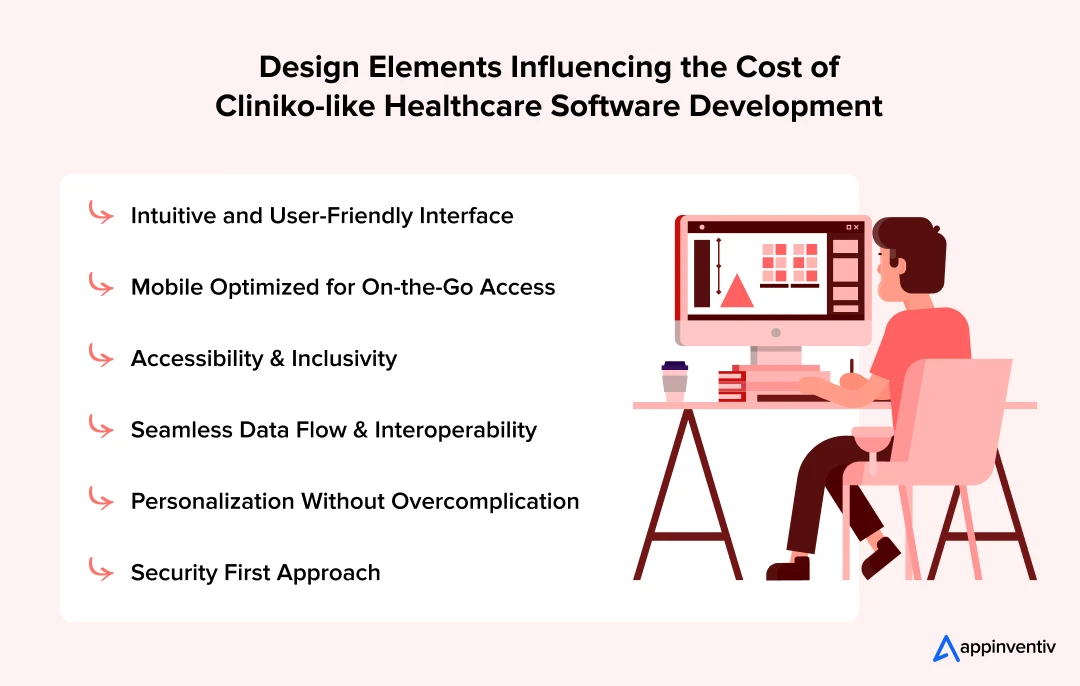 Intuitive and User-Friendly Interface
Intuitive and User-Friendly Interface
Healthcare professionals are often pressed for time, so the system should be easy to navigate with minimal training. A clean dashboard with well-organized menus, clear CTAs, and intuitive workflows ensures that users can find what they need without frustration. Reducing unnecessary clicks and providing guided user flows for first-time users can further enhance usability.
Mobile-Optimized for On-the-Go Access
With the increasing reliance on mobile devices, healthcare professionals and patients alike expect seamless access on smartphones and tablets. To achieve this, a responsive design that adapts to different screen sizes is essential. However, if the target audience includes solo practitioners or multi-location clinics, investing in dedicated iOS and Android apps may improve engagement and convenience.
Accessibility and Inclusivity
Healthcare software must be accessible to users of all abilities. This includes compliance with WCAG (Web Content Accessibility Guidelines), offering features like adjustable text sizes, voice-assisted navigation, and high-contrast modes for visually impaired users. Ensuring that the system supports multiple languages can also help cater to diverse patient demographics.
Seamless Data Flow and Interoperability
A well-designed system doesn’t operate in isolation – it should integrate smoothly with existing tools such as EHR (Electronic Health Records), billing platforms, CRMs, and telehealth services. While designing integration capabilities, Open APIs, HL7/FHIR compliance, and real-time data synchronization should be highlighted to ensure that patient information flows securely across all necessary touchpoints, reducing administrative burdens.
Personalization Without Overcomplication
If building a white-label solution, clinics and hospitals should be able to customize branding elements such as logos, color schemes, and appointment reminders. However, offering too many customization options at the core functional level can lead to unnecessary complexity. To solve this, a balance between flexibility and simplicity should be maintained to ensure that clients can make the system their own without overwhelming setup requirements.
Security-First Approach
Healthcare software must be designed with security and compliance in mind from the outset and on that front, data encryption, multi-factor authentication, role-based access control, and automatic session timeouts, when implemented properly can help protect patient information. Compliance with HIPAA (US), GDPR (EU), and My Health Record (Australia) should also be factored into the design to ensure legal adherence from day one.
The goal of an effective HPMS design is to create a seamless experience for both healthcare professionals and patients – ensuring that the system is easy to use, accessible, and secure. By focusing on usability, interoperability, and security, entrepreneurs can create a product that stands out in the competitive healthcare market while offering true value to its users.
Tech Stack Powering Cliniko-Like Healthcare Practice Management Software Development Costs
The choice of technology stack significantly impacts the cost to develop healthcare practice management software like Cliniko. A well-structured stack ensures smooth functionality, regulatory compliance, and future scalability while keeping development and maintenance costs in check.
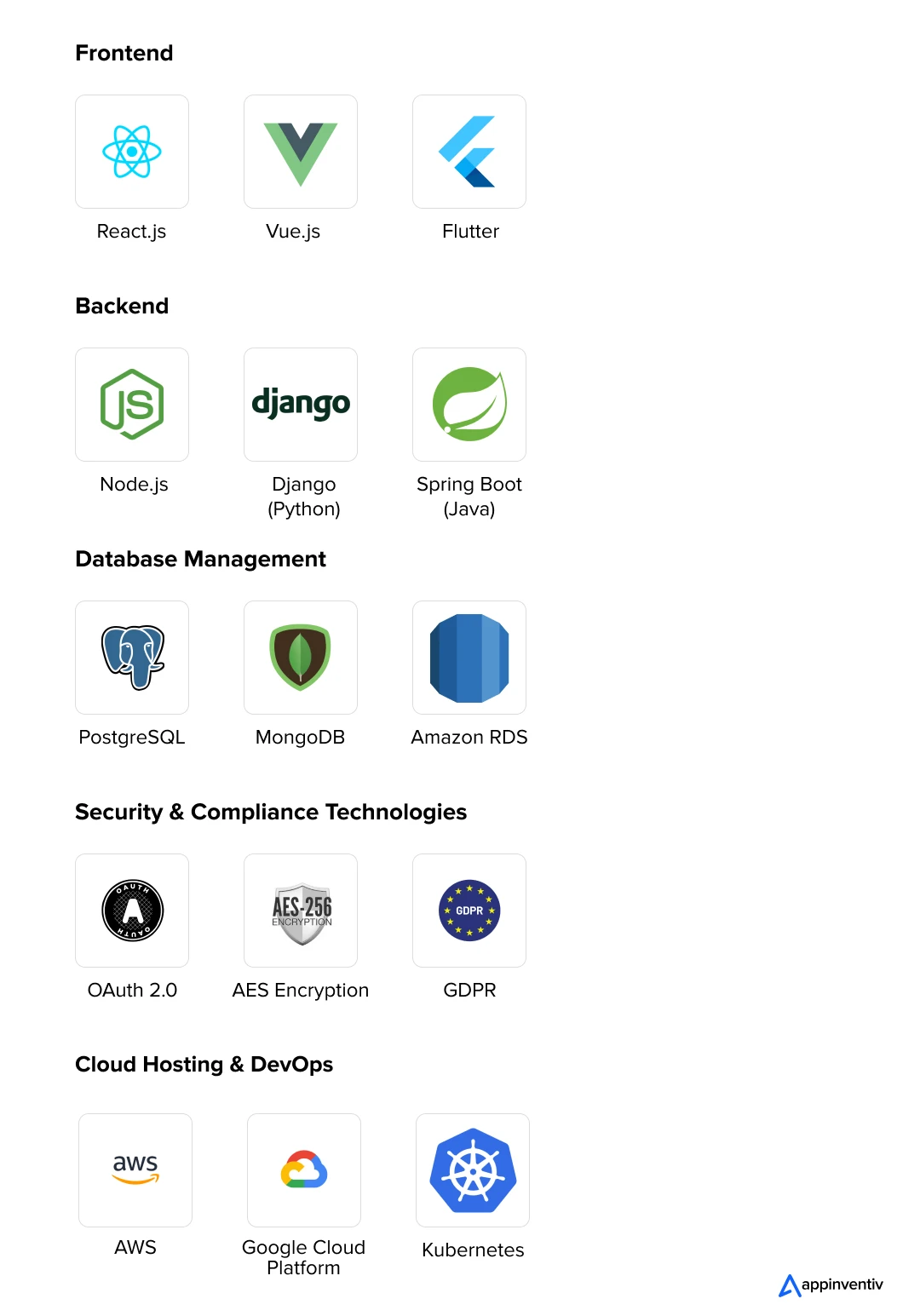
Emerging Technologies to Consider
The healthcare industry is evolving, and integrating emerging technologies can add significant value to a HPMS.
- AI & Machine Learning – AI-powered chatbots can assist in appointment scheduling, while ML-driven analytics can predict patient demand and optimize resource allocation.
- Blockchain for Data Security – Blockchain can enhance data integrity, ensuring secure and tamper-proof patient records.
- IoT for Remote Monitoring – Integration with smart medical devices allows real-time tracking of patient vitals, improving telehealth capabilities.
- Voice Recognition & NLP – AI-powered voice assistants can streamline documentation, reducing the time spent on administrative tasks.
- AR/VR for Training & Telehealth – Augmented and virtual reality can improve remote consultations and medical training experiences.
While traditional stacks ensure stability, integrating emerging technologies can give entrepreneurs a competitive edge, making their software more intelligent, efficient, and future-proof.
By leveraging the right combination of technologies, businesses can build a performing solution that meets the evolving demands of the healthcare industry without exceeding the healthcare practice management software development cost range.
Healthcare Practice Management Software Development Process – The Steps
The development process is a critical factor in determining the healthcare practice management software development costs, timeline, and the overall success.
A well-planned approach ensures that businesses invest their budget wisely, avoiding unnecessary expenses while still achieving a high-quality, scalable product. Entrepreneurs must carefully consider which development methodology to follow, which stages to prioritize, and where to invest for maximum returns.
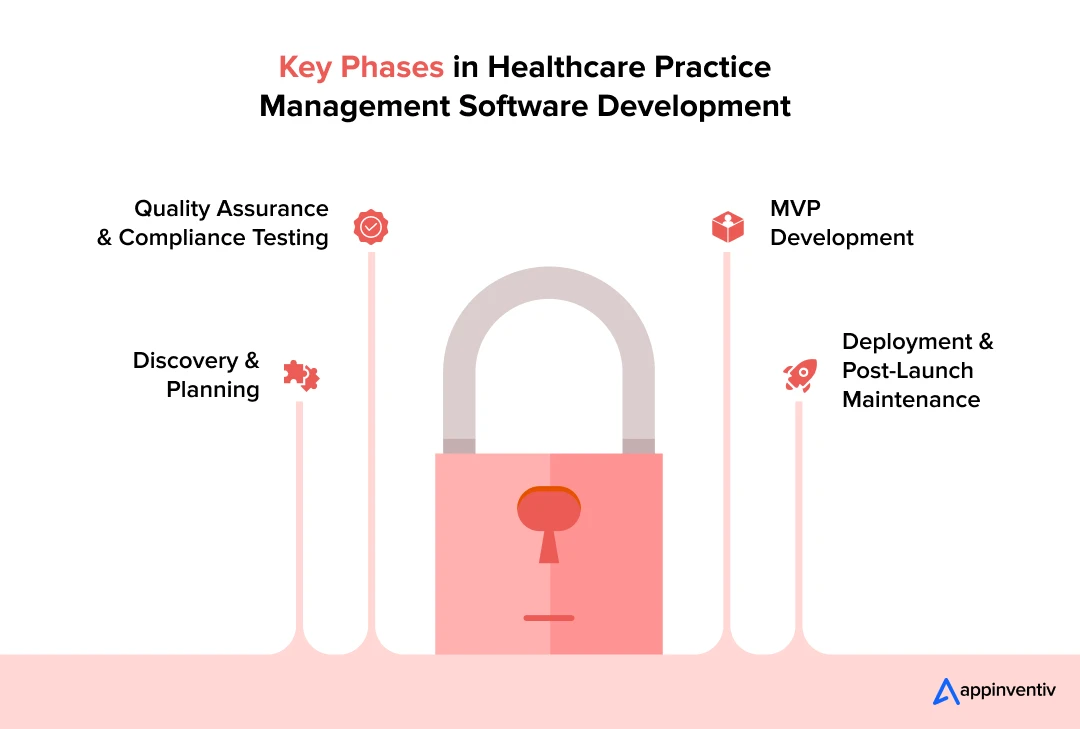 Discovery & Planning
Discovery & Planning
Skipping the planning phase often leads to costly rework later. This stage involves:
- Market research & competitor analysis – Understanding what existing solutions offer and identifying gaps.
- Feature prioritization – Deciding which features are essential for the MVP and which can be added later to manage costs.
- Technical feasibility assessment – Ensuring chosen technologies align with scalability and compliance requirements.
- Wireframing & prototyping – Low-cost design iterations that help validate user experience before full development begins.
Cost Impact: A well-structured discovery phase minimizes wasted resources and avoids expensive changes during development.
MVP Development
Instead of building a full-fledged product from the start, businesses should develop a Minimum Viable Product – a functional version with core features. This allows early market testing while keeping initial development costs under control.
Key focus areas for an MVP:
- Essential features only – Booking, scheduling, health records, and basic financial management.
- User testing & feedback collection – Identifying usability issues before scaling up.
- Scalability considerations – Ensuring the architecture can handle future expansions.
Cost Impact: MVP development prevents overspending by testing market demand before committing to full-scale development.
Agile vs. Waterfall
The development methodology plays a major role in project costs.
- Agile Development (Recommended for Cost Efficiency)
1- Breaks the project into smaller iterations (sprints), allowing gradual improvements based on user feedback.
2- Reduces upfront costs and prevents budget overruns by continuously refining the product.
3- Faster time-to-market, enabling early monetization.
- Waterfall Development
1- A traditional, linear approach where all requirements are finalized upfront.
2- Best for projects with fixed budgets but lacks flexibility to adapt to market changes.
Cost Impact: Agile development optimizes cost by ensuring businesses pay for only what is necessary, while Waterfall may lead to higher expenses due to rigid planning.
- Quality Assurance & Compliance Testing
Healthcare software must meet strict regulatory and security standards. Cutting corners in this phase can lead to compliance fines, legal risks, and system vulnerabilities, making early investment in QA testing essential.
- Automated testing for faster bug detection.
- Manual usability testing to ensure a smooth experience for healthcare professionals.
- Regulatory compliance checks (HIPAA, GDPR, My Health Record) to avoid costly rework post-launch.
Cost Impact: Investing in testing upfront reduces risks of non-compliance fines and costly post-launch bug fixes.
- Deployment & Post-Launch Maintenance
A common mistake is underestimating the costs of deployment and ongoing maintenance. These include:
- Cloud hosting & infrastructure costs (AWS, Azure, Google Cloud).
- Security updates & bug fixes to prevent cyber threats.
- Feature upgrades based on user feedback to maintain competitiveness.
Cost Impact: A well-maintained system ensures long-term stability and prevents unexpected operational costs.
The development process is one of the key factors influencing the cost of software development like Cliniko. By making strategic investments in the right development approach, businesses can maximize their ROI while keeping the development costs optimized.
Monetization Models for Your Version of Cliniko 2.0
As you must have gathered up until now, the cost to develop healthcare practice management software like Cliniko which typically ranges from $40,000 to $300,000 is a massive investment. For entrepreneurs who are just starting in the domain, it is crucial that they know the ways to monetize from the software.
Building a healthcare practice management software is a significant investment, but with the right monetization strategies, businesses can generate steady revenue while offering value to hospitals, clinics, and independent practitioners. Below are the most effective ways to monetize the platform and gain a competitive edge over Cliniko.
 Subscription-Based Pricing
Subscription-Based Pricing
To avail maximum benefits of building a healthcare practice management software, a Software-as-a-Service model would be the most common and predictable way to generate revenue. Users pay a monthly or yearly subscription fee based on:
- Number of users or practitioners (e.g., solo practitioners pay less than multi-clinic setups).
- Feature access (basic vs. premium plans with advanced analytics, automation, and integrations).
- Storage and usage limits (higher tiers offer more patient records, cloud storage, and telehealth minutes).
White-Label Licensing for Enterprises
If the software is designed to be white-labeled, hospitals, large clinics, or telehealth platforms can purchase a custom-branded version for a licensing fee.
- Offer one-time licensing fees for full ownership.
- Provide subscription-based licensing where organizations pay annually for continued updates and support.
- Introduce a hybrid model with a setup fee plus ongoing payments for maintenance.
Transaction Fees on Payments
If the platform includes online payment processing, a small commission on transactions can create an additional revenue stream.
- Charge a percentage of payments processed through the platform.
- Partner with payment gateways (Stripe, PayPal, Square) to offer seamless transactions while earning a share of the fees.
- Offer lower fees for premium users, encouraging upgrades.
Marketplace & Third-Party Integrations
Develop a marketplace for third-party apps and integrations, allowing clinics to extend their software with additional tools.
- Partner with EHR providers, telehealth platforms, insurance billing services, and diagnostic tools.
- Charge a commission on third-party app purchases.
- Offer API access as a paid feature for hospitals wanting to connect their existing systems.
Premium Add-Ons & AI-Powered Features
Instead of bundling everything into one plan, businesses can introduce premium add-ons for advanced functionalities:
- AI-powered analytics & predictions – Smart scheduling, automated patient follow-ups, and financial forecasting.
- Advanced telehealth capabilities – HD video calls, multi-party conferencing, and virtual reality consultations.
- Custom branding options – Clinics pay extra to personalize their dashboard, invoices, and reports.
How to Get a Competitive Edge Over Cliniko
Cliniko is a strong player in the market, but you can differentiate their software by offering. Here are the few steps tp undertake:
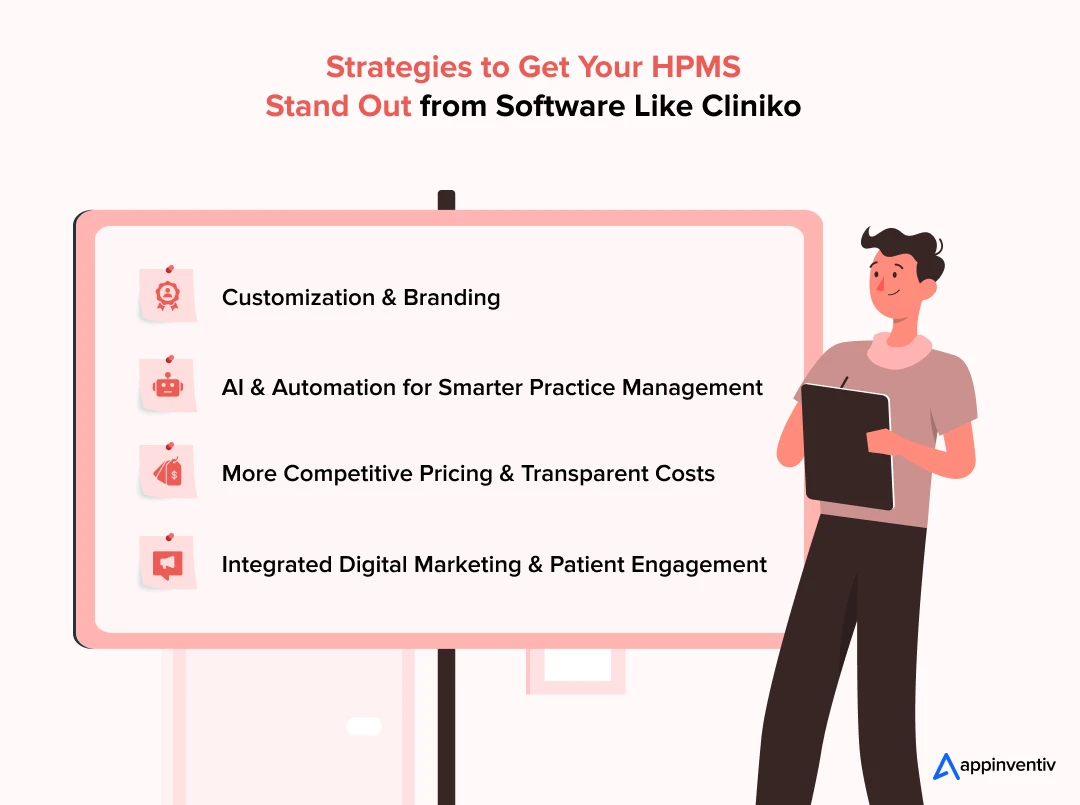 Customization & Branding
Customization & Branding
Cliniko offers limited white-labeling, meaning clinics can’t fully rebrand it. To stand out:
- Offer complete white-labeling, allowing full customization of logos, themes, and domain names.
- Provide tailored user experiences, allowing clinics to modify dashboards and workflows.
AI & Automation for Smarter Practice Management
Cliniko’s automation features are basic. To gain an edge:
- Introduce AI-powered appointment reminders, dynamic scheduling, and patient engagement tools.
- Use predictive analytics to optimize staffing and reduce cancellations.
More Competitive Pricing & Transparent Costs
Cliniko’s pricing structure has limited flexibility. Offer:
- Modular pricing, where clinics pay only for features they need.
- Better transaction fee models, reducing costs for high-volume users.
Integrated Digital Marketing & Patient Engagement
Cliniko lacks built-in marketing tools. Stand out by:
- Offering patient engagement features, such as automated marketing campaigns and loyalty programs.
- Providing SEO-friendly booking pages for clinics to attract more patients online.
Entrepreneurs entering the white-label HPMS space should focus on diverse monetization strategies. Ultimately, by building a feature-rich, highly adaptable, and cost-effective alternative, businesses can attract more clinics, increase revenue streams, and establish a competitive position in the healthcare SaaS market.
Appinventiv’s Role in Creating Feature-rich Healthcare Practice Management Software
At Appinventiv, our software developers in Brisbane and other parts of Australia, including, Melbourne, Perth, Sydney, and more, don’t just build healthcare software – we craft high-performing, scalable, and fully customizable solutions that set you apart from competitors like Cliniko. Whether you’re launching a new platform or looking to enhance an existing one, we make sure your software is built faster, smarter, and with cost-efficiency in mind.
1- We Handle the Entire Development Journey, So You Can Focus on Growth
Building a healthcare practice management system isn’t just about writing code. It’s about getting the strategy, compliance, and scalability right from day one. As a firm offering healthcare software development in Australia, we take care of:
- Strategic planning & market validation
- MVP development to minimize risk
- HIPAA & GDPR compliance
- Scalable cloud infrastructure
By working closely with you, we trim unnecessary costs, prioritize high-impact features, and accelerate your time to market.
2- We Make Your Platform 100% Customizable
Cliniko limits branding options – but we help you build a platform that’s truly white-label. Your customers (clinics, hospitals, or solo practitioners) should be able to:
- Rebrand the entire interface
- Customize dashboards & workflows
- Seamlessly integrate third-party tools
3- We Integrate AI & Automation to Give You a Competitive Edge
Cliniko offers basic automation – but we push the boundaries by integrating AI-driven intelligence into your platform:
- Smart appointment scheduling.
- Predictive analytics for better decision-making.
- AI-powered chatbots for patient engagement.
By embedding next-gen AI capabilities, we don’t just help you compete, we make sure your platform is ahead of the curve.
4- We Optimize Development Costs
We know that cost is a huge factor when building healthcare software. That’s why we take a lean and strategic approach to development:
- Modular architecture.
- Agile development.
- Pre-built components where possible.
With the right planning, we help reduce unnecessary spending while making sure your product is powerful and future-proof.
5- We’re Your Long-Term Tech Partner
As a part of our software development services in Australia, we continue with ongoing software maintenance and optimization once the software is built. We stick with you for:
- Ongoing updates & optimizations.
- Feature enhancements based on market trends.
- Scalability planning.
If you’re looking to develop a high-performance, customizable, and future-proof healthcare practice management system, we’re ready to help. Let’s create something that doesn’t just match Cliniko – it surpasses it in every way.
Ready to get started? Let’s talk.
FAQs
Q. How much does it cost to develop a software like Cliniko?
A. The healthcare practice management software development cost depends on several factors, including feature complexity, integrations, compliance requirements, and development approach.
- A basic version with essential features like appointment scheduling, EHR storage, and billing can cost $40,000–$80,000.
- A mid-range solution with telehealth, AI-driven automation, and advanced reporting can range between $80,000–$150,000.
- A fully customized enterprise-grade solution with multi-clinic support, deep integrations, and predictive analytics can go beyond $200,000.
The cost to develop healthcare practice management software like Cliniko, however, can be optimized by choosing modular architecture, leveraging pre-built components, and adopting agile development methodologies.
Q. Why is white-label practice management software important in healthcare?
A. White-label healthcare practice management software gives clinics, hospitals, and independent practitioners the flexibility to brand and customize the platform as their own. This is essential because:
- Stronger brand identity – Healthcare providers can align the software with their branding, enhancing trust.
- Faster adoption – Pre-built solutions reduce implementation time, helping providers focus on patient care.
- Scalability – A white-label model allows businesses to cater to multiple providers with different needs.
- Recurring revenue opportunities – For entrepreneurs, it provides a way to monetize software through subscription-based models.
Unlike off-the-shelf solutions, white-label platforms give providers full control over workflows, integrations, and data management.
Q. How long does it take to develop a healthcare practice management software like Cliniko in Australia?
A. The timeline depends on the development approach and feature set:
- MVP Development – 3 to 6 months (for core features like booking, billing, and patient records).
- Full-scale product development – 6 to 12 months (for AI automation, telehealth, deep integrations, and multi-clinic support).
- Enterprise-level solution – 12+ months (for highly customized, scalable, and regulatory-compliant systems).
Factors like HIPAA, GDPR, and Australian Digital Health compliance can also impact the timeline, requiring thorough security measures and testing before launch.
Q. What are the challenges with healthcare practice management software development?
A. Developing an HPMS comes with unique challenges, including:
- Regulatory Compliance – Ensuring the platform meets HIPAA, GDPR, and Australia’s My Health Record System standards.
- Scalability & Multi-Tenant Architecture – Designing the software to support multiple clinics with separate data access controls.
- Data Security & Privacy – Implementing end-to-end encryption, access controls, and audit logs to protect patient records.
- Customization Without Complexity – Balancing flexibility with ease of use so clinics can personalize their software without needing technical expertise.
- Cost & ROI Optimization – Managing development costs while ensuring the software remains profitable through subscription models, integrations, or add-on features.
With the right tech strategy and development partner, these challenges can be effectively managed, ensuring a secure, scalable, and competitive product.


- In just 2 mins you will get a response
- Your idea is 100% protected by our Non Disclosure Agreement.

How Much Does It Cost to Build a White-Label Enterprise Procurement Software?
Key takeaways: The development of white-label enterprise procurement software typically costs between $50,000 and $500,000, depending on complexity and features. Key features include vendor management, budget tracking, purchase approvals, and invoice automation. Flexible monetization models - from modular licensing to integration fees- can future-proof revenue streams. Building a custom white-label solution gives you long-term control…

A Clear Breakdown of Custom Software Development Costs for Businesses in Canada
Key takeaways: Custom software in Canada typically ranges from CAD 55,00 to 550,000 ($40,000 to $400,000), depending on scope, integrations, and compliance. Costs rise in regulated sectors due to PHIPA, PCI DSS, AML rules, and strict Canadian data residency requirements. Planning, modular architecture, and cloud native services help control the software development cost in Canada…

The Real Cost of Building Professional Delivery Management Software
Key takeaways: Custom delivery management software has complete flexibility, scale, and integration, which conforms to the distinctive requirements of business. Fluid connection to ERP, CRM, and payment systems also introduces a large amount of complexity and additional cost, but is the key to efficiency. It is important to design scalable systems to grow in the…








